Answered step by step
Verified Expert Solution
Question
1 Approved Answer
SELECTION 2 Science 457 CHECK YOUR COMPREHENSION Main Idea After reading the selection, answer the following questions with a, b, c, or d. To help
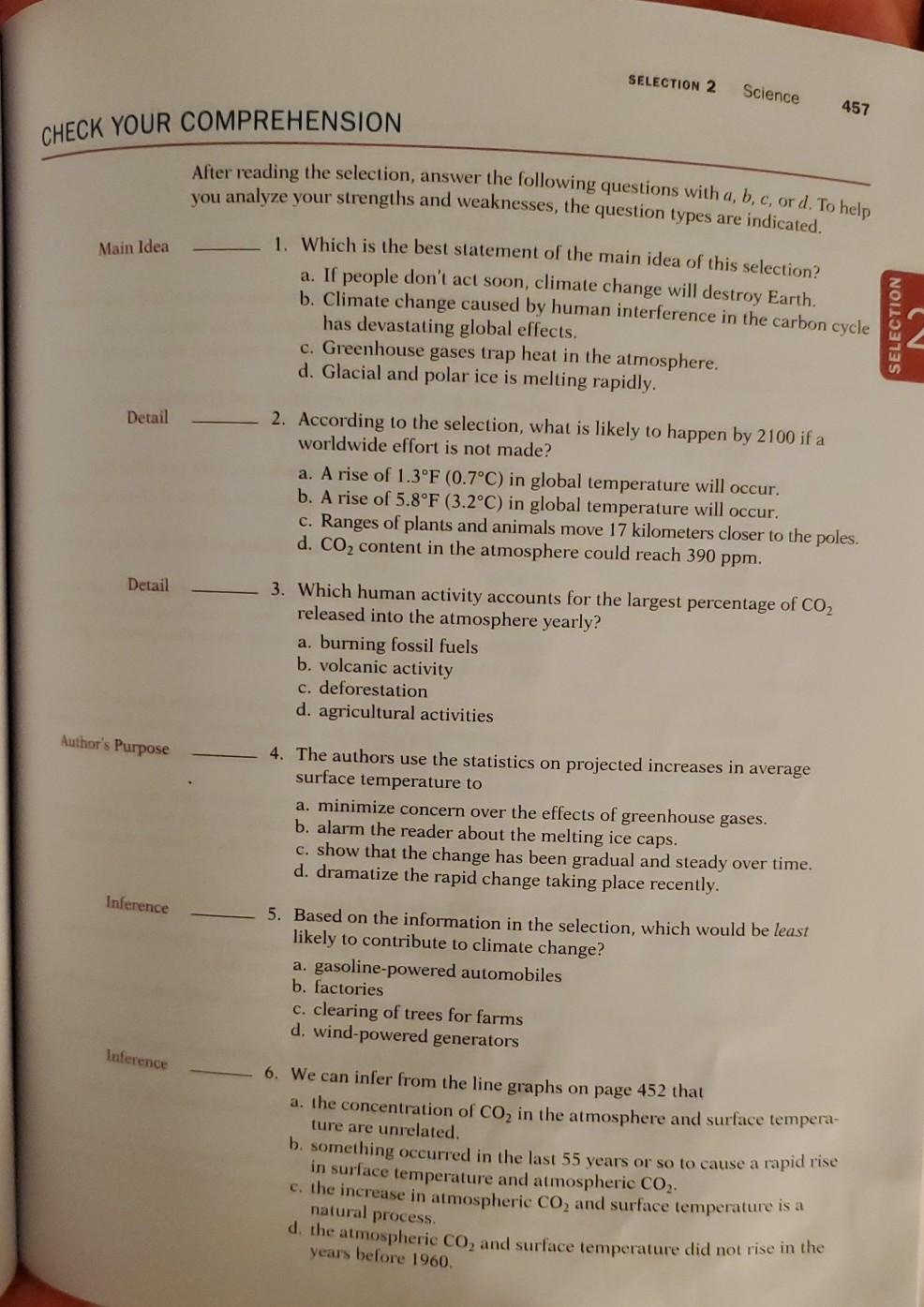
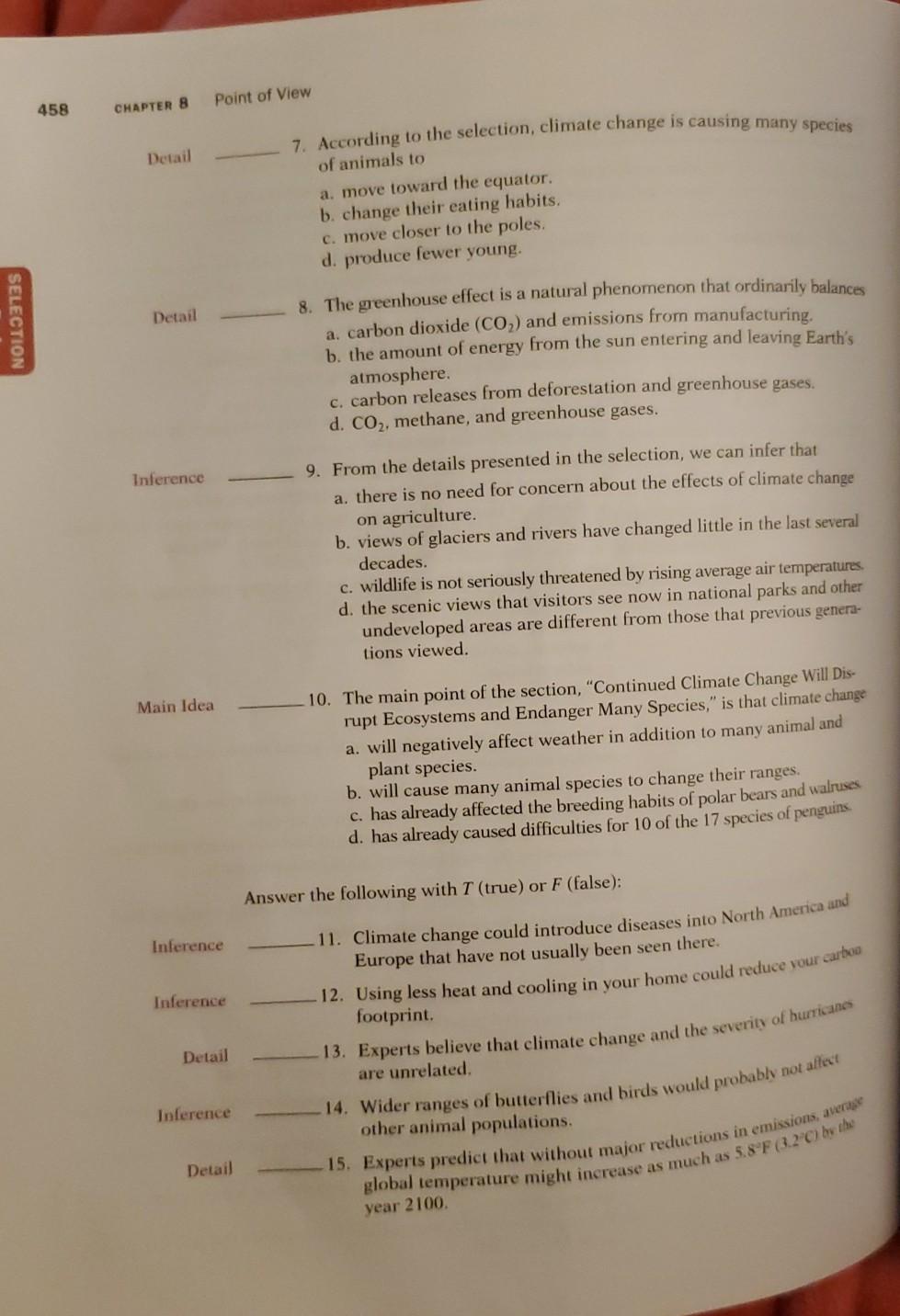
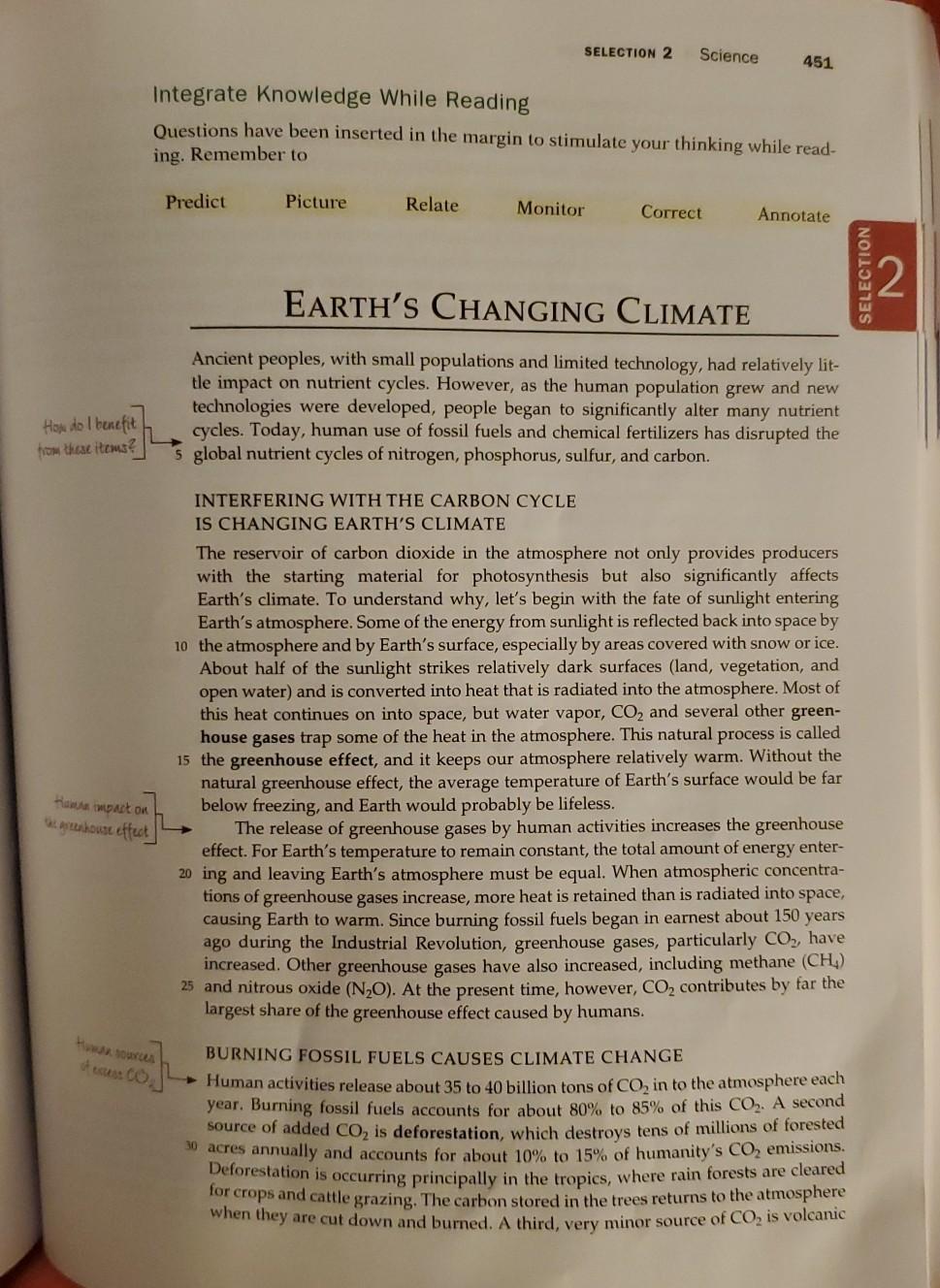

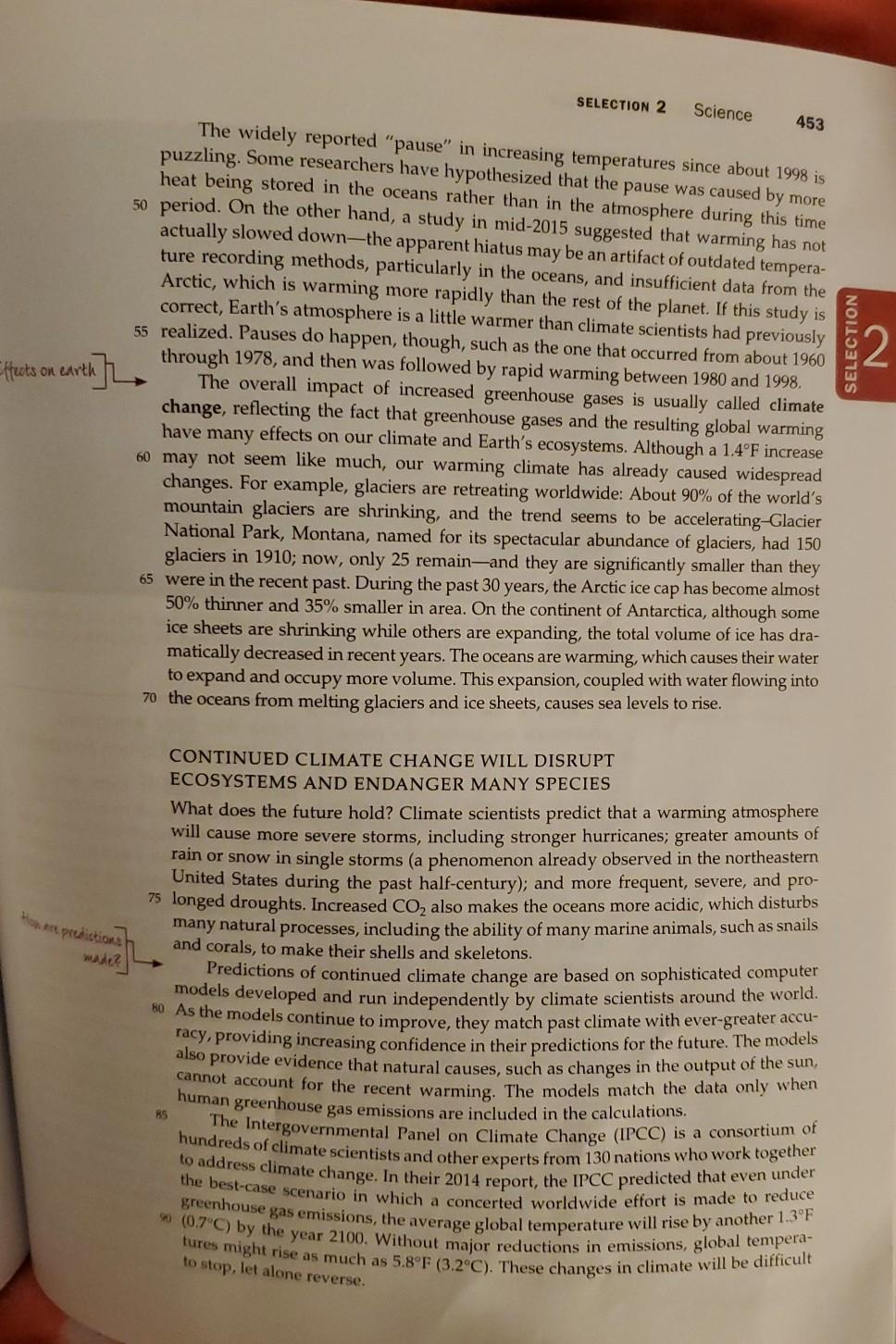
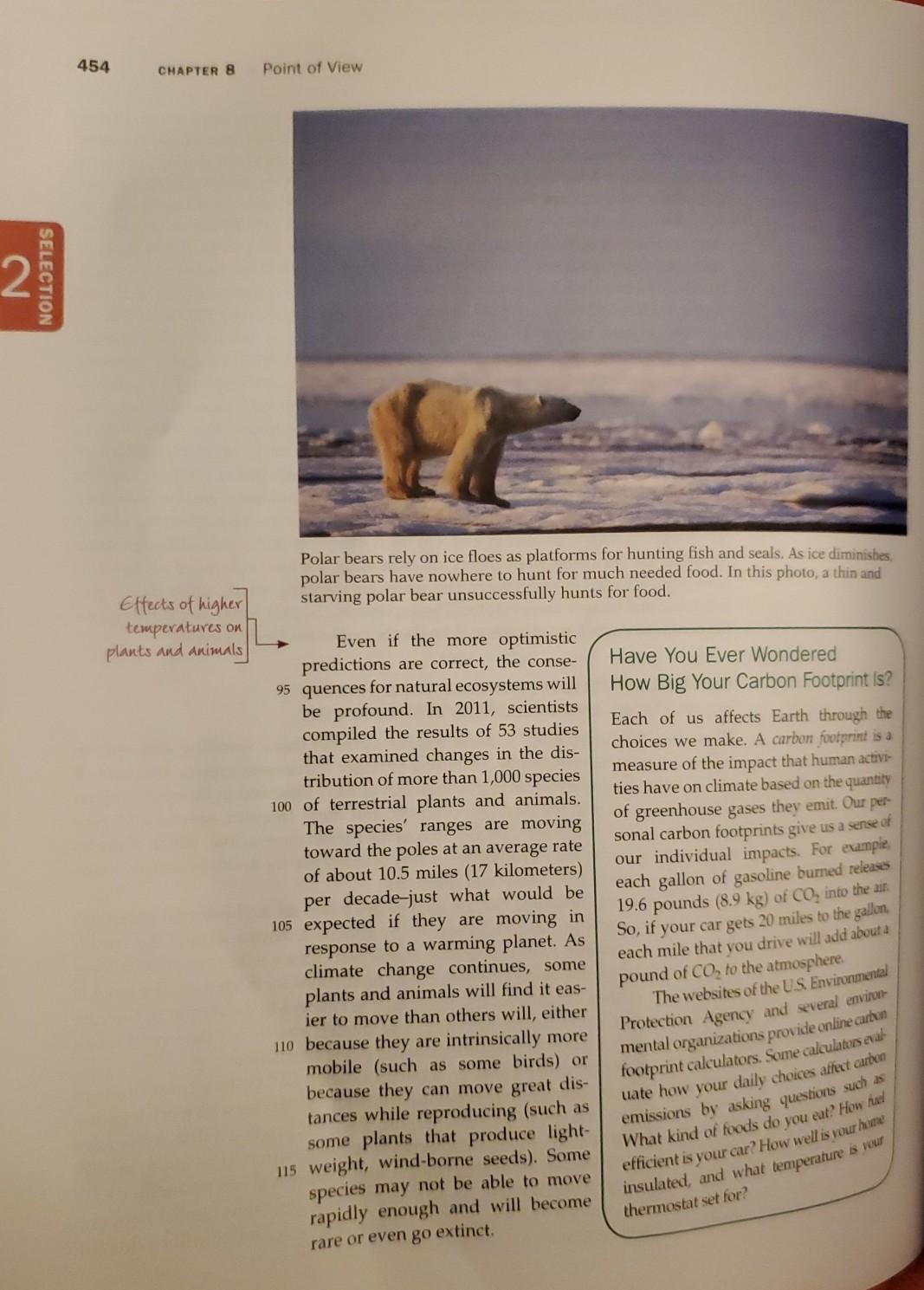
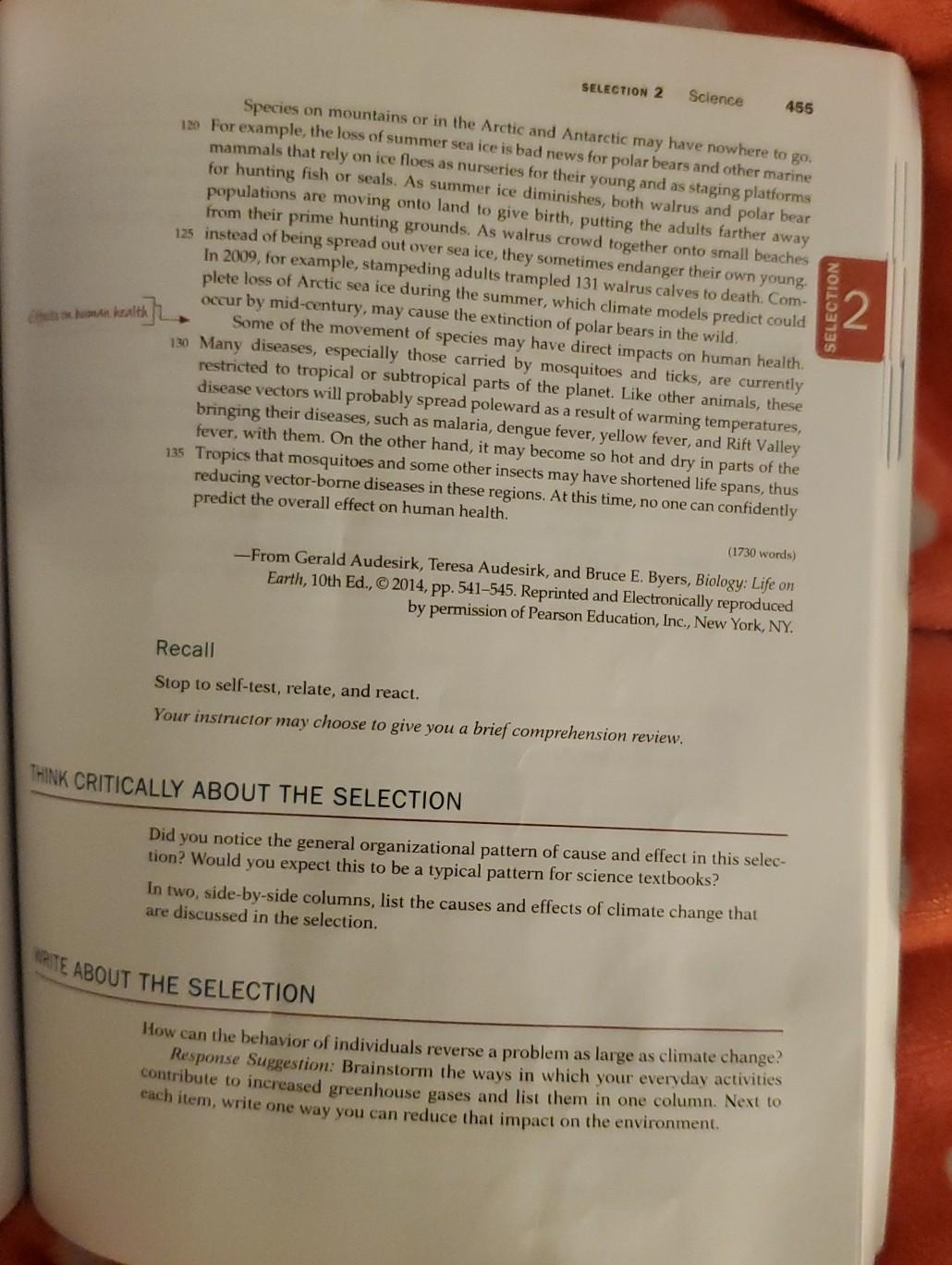
SELECTION 2 Science 457 CHECK YOUR COMPREHENSION Main Idea After reading the selection, answer the following questions with a, b, c, or d. To help you analyze your strengths and weaknesses, the question types are indicated. 1. Which is the best statement of the main idea of this selection? a. Il people don't act soon, climate change will destroy Earth. b. Climate change caused by human interference in the carbon cycle has devastating global effects. c. Greenhouse gases trap heat in the atmosphere. d. Glacial and polar ice is melting rapidly. SELECTION Detail 2. According to the selection, what is likely to happen by 2100 if a worldwide effort is not made? a. A rise of 1.3F (0.7C) in global temperature will occur. b. A rise of 5.8F (3.2C) in global temperature will occur. c. Ranges of plants and animals move 17 kilometers closer to the poles. d. CO2 content in the atmosphere could reach 390 ppm. Detail 3. Which human activity accounts for the largest percentage of CO2 released into the atmosphere yearly? a. burning fossil fuels b. volcanic activity c. deforestation d. agricultural activities Author's Purpose 4. The authors use the statistics on projected increases in average surface temperature to a. minimize concern over the effects of greenhouse gases. b. alarm the reader about the melting ice caps. c. show that the change has been gradual and steady over time. d. dramatize the rapid change taking place recently. Inference 5. Based on the information in the selection, which would be least likely to contribute to climate change? a. gasoline-powered automobiles b. factories c. clearing of trees for farms d, wind-powered generators Inference 6. We can infer from the line graphs on page 452 that a. the concentration of CO2 in the atmosphere and surface tempera- ture are unrelated. b. something occurred in the last 55 years or so to cause a rapid rise in surface temperature and atmospheric CO2, c, the increase in atmospheric CO, and surface temperature is a d. the atmospheric CO2 and surface temperature did not rise in the years before 1960. natural process. Point of View SELECTION 12. Using less heat and cooling in your home could reduce your carbon 13. Experts believe that climate change and the severity of hurricanes 14. Wider ranges of butterflies and birds would probably not affect 15. Experts predict that without major reductions in emissions, averse global temperature might increase as much as 5.8F (3.2C by the 458 CHAPTER 8 7. According to the selection, climate change is causing many species Detail of animals to a. move toward the equator. b. change their eating habits. c. move closer to the poles. d. produce fewer young. Detail 8. The greenhouse effect is a natural phenomenon that ordinarily balances a. carbon dioxide (CO) and emissions from manufacturing. b. the amount of energy from the sun entering and leaving Earth's atmosphere. c. carbon releases from deforestation and greenhouse gases. d. Coz, methane, and greenhouse gases. Inference 9. From the details presented in the selection, we can infer that a. there is no need for concern about the effects of climate change on agriculture. b. views of glaciers and rivers have changed little in the last several decades. c. wildlife is not seriously threatened by rising average air temperatures. d. the scenic views that visitors see now in national parks and other undeveloped areas are different from those that previous genera- tions viewed. Main Idea 10. The main point of the section, "Continued Climate Change Will Dis- rupt Ecosystems and Endanger Many Species," is that climate change a. will negatively affect weather in addition to many animal and plant species. b. will cause many animal species to change their ranges. c. has already affected the breeding habits of polar bears and walruses d. has already caused difficulties for 10 of the 17 species of penguins Answer the following with T (true) or F (false): Inference 11. Climate change could introduce diseases into North America and Europe that have not usually been seen there. Inference footprint. Detail are unrelated. Inference other animal populations. Detail year 2100 SELECTION 2 Science 451 Integrate Knowledge While Reading Questions have been inserted in the margin to stimulate your thinking while read- ing. Remember to Predict Picture Relate Monitor Correct Annotate SELECTION 2 EARTH'S CHANGING CLIMATE Ancient peoples, with small populations and limited technology, had relatively lit- tle impact on nutrient cycles. However, as the human population grew and new technologies were developed, people began to significantly alter many nutrient cycles. Today, human use of fossil fuels and chemical fertilizers has disrupted the global nutrient cycles of nitrogen, phosphorus, sulfur, and carbon. Hoxe do I benefit from the items? INTERFERING WITH THE CARBON CYCLE IS CHANGING EARTH'S CLIMATE The reservoir of carbon dioxide in the atmosphere not only provides producers with the starting material for photosynthesis but also significantly affects Earth's climate. To understand why, let's begin with the fate of sunlight entering Earth's atmosphere. Some of the energy from sunlight is reflected back into space by 10 the atmosphere and by Earth's surface, especially by areas covered with snow or ice. About half of the sunlight strikes relatively dark surfaces (land, vegetation, and open water) and is converted into heat that is radiated into the atmosphere. Most of this heat continues on into space, but water vapor, CO2 and several other green- house gases trap some of the heat in the atmosphere. This natural process is called 15 the greenhouse effect, and it keeps our atmosphere relatively warm. Without the natural greenhouse effect, the average temperature of Earth's surface would be far below freezing, and Earth would probably be lifeless. The release of greenhouse gases by human activities increases the greenhouse effect. For Earth's temperature remain constant, the total amount fenergy enter- 20 ing and leaving Earth's atmosphere must be equal. When atmospheric concentra- tions of greenhouse gases increase, more heat is retained than is radiated into space, causing Earth to warm. Since burning fossil fuels began in earnest about 150 years ago during the Industrial Revolution, greenhouse gases, particularly CO., have increased. Other greenhouse gases have also increased, including methane (CH) 25 and nitrous oxide (N2O). At the present time, however, CO, contributes by far the largest share of the greenhouse effect caused by humans. Hawa impact on Blous effect Hwww.sources BURNING FOSSIL FUELS CAUSES CLIMATE CHANGE Human activities release about 35 to 40 billion tons of CO2 in to the atmosphere each year. Burning fossil fuels accounts for about 80% to 85% of this CO2. A second source of added CO2 is deforestation, which destroys tens of millions of forested acres annually and accounts for about 10% to 15% of humanity's CO2 emissions. Deforestation is occurring principally in the tropics, where rain forests are cleared for crops and cattle grazing. The carbon stored in the trees returns to the atmosphere when they are cut down and burned. A third, very minor source of CO, is volcanic of the atmosphere has increased by over 40%-from 280 parts per million (ppm) to activity. The U.S. Geological Survey estimates that less than 1% as much CO, enters About half of the CO2 released each year is absorbed by the oceans and terrestrial plants. The rest of the CO2 remains in the atmosphere. Since 1850, the CO2 content increases. (a) Yearly average CO2 concentrations in parts per million, measured 11.HIlar Figure (a) & Figure (b). Global temperature increases parallel atmospheric co, (3,396 meters) above sea level, on Mauna Loa, Hawaii. (b) Although global average tempera tures fluctuate considerably from year to year, there is a clear upward trend over time Gerald Audesirk; Teresa Audesirk: Bruce E. Byers, Biology: Life on Earth, 10 Ed. 2014, pp 544.6 Reprinted and Electronically by permission of Pearson Education, Inc., New York NY 452 35 the atmosphere from volcanoes as from human activities Point of View CHAPTER 8 The evidence SELECTION about 400 ppm in 2014 and is growing by about 2 ppm annually (Figure a 40 Atmospheric CO2 is now higher than at any time in the past 800,000 years. A large and growing body of evidence indicates that human release of Co, and other greenhouse gases has amplified the natural greenhouse effect, altering the global climate. Air temperatures at Earth's surface, recorded at thousands of sites de land and sea, show that Earth has warmed by about: 1.4F (0.8C) since the late 45 1800s, including an increase of 1F (0.6C) just since the 1970s (Figure b). All but 1 of the 15 warmest years on record have occurred since 2000. CO2 (ppm) 400 390 380 370 360 350 340 330 320 310- 300 1960 1970 1980 1990 2000 2010 year (a) Atmospheric CO2 F C 14.6- 58.1 14.5 57.9 14.4 57.7 14.3 Global average temperature 57.6 14.2 57.4 14.1 57.2 14.0 57.0 13.9 56.8 13.8 - Zupanua 2010 13.7 1960 1990 2000 1970 1980 year (b) Global surface temperature tures might rise as much as 5.8F (3.2C). These changes in climate will be difficult Science 453 hundreds of climate scientists and other experts from 130 nations who work together to address climate change. In their 2014 report, the IPCC predicted that even under the best-case scenario in which a concerted worldwide effort is made to reduce % (0.7C) by the year 2100. Without major reductions in emissions, global tempera- greenhouse gas emissions, the average global temperature will rise by another 1.3F SELECTION 2 The widely reported "pause" in increasing temperatures since about 1998 is puzzling. Some researchers have hypothesized that the pause was caused by more heat being stored in the oceans rather than in the atmosphere during this time 50 period. On the other hand, a study in mid-2015 suggested that warming has not actually slowed down the apparent hiatus may be an artifact of outdated tempera- ture recording methods, particularly in the oceans, and insufficient data from the Arctic, which is warming more rapidly than the rest of the planet. If this study is correct, Earth's atmosphere is a little warmer than climate scientists had previously 2 55 , through 1978, and then was followed by rapid warming between 1980 and 1998. Effects on earth The overall impact of increased greenhouse gases is usually called climate change, reflecting the fact that greenhouse gases and the resulting global warming have many effects on our climate and Earth's ecosystems. Although a 1.4F increase 60 may not seem like much, our warming climate has already caused widespread changes. For example, glaciers are retreating worldwide: About 90% of the world's mountain glaciers are shrinking, and the trend seems to be accelerating-Glacier National Park, Montana, named for its spectacular abundance of glaciers, had 150 glaciers in 1910; now, only 25 remain-and they are significantly smaller than they 65 were in the recent past. During the past 30 years, the Arctic ice cap has become almost 50% thinner and 35% smaller in area. On the continent of Antarctica, although some ice sheets are shrinking while others are expanding, the total volume of ice has dra- matically decreased in recent years. The oceans are warming, which causes their water to expand and occupy more volume. This expansion, coupled with water flowing into 70 the oceans from melting glaciers and ice sheets, causes sea levels to rise. CONTINUED CLIMATE CHANGE WILL DISRUPT ECOSYSTEMS AND ENDANGER MANY SPECIES What does the future hold? Climate scientists predict that a warming atmosphere will cause more severe storms, including stronger hurricanes; greater amounts of rain or snow in single storms (a phenomenon already observed in the northeastern United States during the past half-century); and more frequent, severe, and pro- 75 longed droughts. Increased CO2 also makes the oceans more acidic, which disturbs many natural processes, including the ability of many marine animals, such as snails and corals, to make their shells and skeletons. Predictions of continued climate change are based on sophisticated computer models developed and run independently by climate scientists around the world. 80 As the models continue to improve, they match past climate with ever-greater accu- Tcy, providing increasing confidence in their predictions for the future. The models also provide evidence that natural causes, such as changes in the output of the sun, cannot account for the recent warming. The models match the data only when human greenhouse gas emissions are included in the calculations. The Intergovernmental Panel on Climate Change (IPCC) is a consortium of 85 to stop, let alone reverse. WRITE ABOUT THE SELECTION SELECTION 2 Science 455 mit health Species on mountains or in the Arctic and Antarctic may have nowhere to go 12 For example, the loss of summer sea ice is bad news for polar bears and other marine mammals that rely on ice floes as nurseries for their young and as staging platforms for hunting fish or seals. As summer ice diminishes, both walrus and polar bear populations are moving onto land to give birth, putting the adults farther away from their prime hunting grounds. As walrus crowd together onto small beaches 125 instead of being spread out over sea ice, they sometimes endanger their own young. In 2009, for example, stampeding adults trampled 131 walrus calves to death Com- plete loss of Arctic sea ice during the summer, which climate models predict could occur by mid-century, may cause the extinction of polar bears in the wild Some of the movement of species may have direct impacts on human health 130 Many diseases, especially those carried by mosquitoes and ticks, are currently restricted to tropical or subtropical parts of the planet. Like other animals, these disease vectors will probably spread poleward as a result of warming temperatures, bringing their diseases, such as malaria, dengue fever, yellow fever, and Rift Valley fever, with them. On the other hand, it may become so hot and dry in parts of the 135 Tropics that mosquitoes and some other insects may have shortened life spans, thus reducing vector-borne diseases in these regions. At this time, no one can confidently predict the overall effect on human health. (1730 words) SELECTION 2 - From Gerald Audesirk, Teresa Audesirk, and Bruce E. Byers, Biology: Life on Earth, 10th Ed., 2014, pp. 541-545. Reprinted and Electronically reproduced by permission of Pearson Education, Inc., New York, NY. Recall Stop to self-test, relate, and react. Your instructor may choose to give you a brief comprehension review. THINK CRITICALLY ABOUT THE SELECTION Did you notice the general organizational pattern of cause and effect in this selec- tion? Would you expect this to be a typical pattern for science textbooks? In two, side-by-side columns, list the causes and effects of climate change that are discussed in the selection. How can the behavior of individuals reverse a problem as large as climate change? Response Suggestion: Brainstorm the ways in which your everyday activities contribute to increased greenhouse gases and list them in one column. Next to each item, write one way you can reduce that impact on the environment
Step by Step Solution
There are 3 Steps involved in it
Step: 1

Get Instant Access to Expert-Tailored Solutions
See step-by-step solutions with expert insights and AI powered tools for academic success
Step: 2

Step: 3

Ace Your Homework with AI
Get the answers you need in no time with our AI-driven, step-by-step assistance
Get Started


